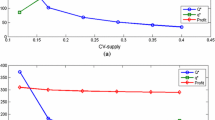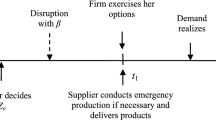Abstract
We discuss challenges that arise in practice of procurement contracting from supply disruptions and suggest how the theory should be adjusted to address these challenges. The challenges range from the loss of contract power when unexpected shocks occur to the need for contracts to govern joint risk management efforts of buyers and sellers. We highlight which traditional contracting modeling assumptions need to be reexamined and how our intuition based on the classical results might change. We point out a new direction of impactful research—coordination of supply risk management efforts among firms.
Access this chapter
Tax calculation will be finalised at checkout
Purchases are for personal use only
Similar content being viewed by others
Notes
- 1.
The official prize title is “The Sveriges Riksbank Prize in Economic Sciences in Memory of Alfred Nobel”.
- 2.
This list includes: Jean Tirole, Peter A. Diamond, Oliver E. Williamson, Leonid Hurwicz, Eric S. Maskin, Roger B. Myerson, Robert J. Aumann, Thomas C. Schelling, George A. Akerlof, A. Michael Spence, Joseph E. Stiglitz, James A. Mirrlees, William Vickrey, and for the contributions to the game theory John C. Harsanyi, John F. Nash Jr., and Reinhard Selten.
- 3.
- 4.
Earlier work on random yield management falls into this category, see review article by Yano and Lee (1995). More recently, a number of papers on supply disruptions and the value of such strategies as diversification, backup production, inventory, insurance have appeared. See review articles and chapters by Tang (2006), Tomlin and Wang (2011), Snyder et al. (2012).
- 5.
- 6.
Source: http://www.gafta.com/contracts.
- 7.
- 8.
- 9.
Such condition ensures that the buyer orders the system’s optimal quantity.
- 10.
- 11.
Adapted from Proposition 1 of Yang et al. (2009).
- 12.
The results in this table is obtained by applying \(b = \infty\) to Proposition 2 of Yang et al. (2009).
- 13.
The results can be derived by applying \(b = \infty\) and c L = c H = c to Proposition 3 of Yang et al. (2009).
References
Alchian AA, Demsetz H (1972) Production, information costs, and economic organization. Am Econ Rev 62(5):777–795
Anupindi R, Bassok Y, Zemel E (2001) A general framework for the study of decentralized distribution systems. Manuf Serv Oper Manag 3(4):349–368
Aydin G, Babich V, Beil DR, Yang Z (2011) Decentralized supply risk management. In: Kouvelis P, Boyabatli O, Dong L, Li R (eds) Handbook of integrated risk management in global supply chains, Chap. 14 Wiley, New York, pp 389–424
Babich V (2006) Vulnerable options in supply chains: effects of supplier competition. Nav. Res. Logist. 53(7):656–673
Babich V, Tang CS (2012) Managing opportunistic supplier product adulteration: deferred payments, inspection, and combined mechanisms. Manuf. Serv. Oper Manag. 14(2):301–314
Babich V, Aydin G, Brunet P-Y, Keppo J, Saigal R (2012) Risk, financing, and the optimal number of suppliers. In: Gurnani H, Mehrotra A, Ray S (eds) Managing supply disruptions, Chap. 8 Springer, London, pp 195–240
Baiman S, Fischer PE, Rajan MV (2000) Information, contracting, and quality costs. Manag Sci 46(6):776–789
Binmore K, Rubinstein A, Wolinsky A (1986) The Nash bargaining solution in economic modelling. RAND J Econ 17(2, Summer):176–188
Bolton P, Dewatripont M (2005) Contract theory. MIT Press, Cambridge, MA
Cachon GP (2003) Supply chain coordination with contracts. In: de Kok AG, Graves SC (eds) Handbooks in operations research and management science, vol. 11, Chap. 6 Elsevier, Amsterdam, pp 227–339
Chaturvedi A, Martínez-de Albéniz V (2011) Optimal procurement design in the presence of supply risk. Manuf Serv Oper Manag 13(2):227–243
Chod J, Zhou J (2013) Resource flexibility and capital structure. Manag Sci 60(3):708–729
Clyde & Co (2012) 50 shades of grain. Technical report. Clyde & Co, London
Gillenwater G (2008) Supplier for Chrysler files bankruptcy. http://www.lawyersandsettlements.penalty0com/articles/bankruptcy_debt_help/bankruptcy-chrysler-01889.html#.Vc54e3j92M4
Graves SC, de Kok A (eds) (2003) Handbooks in operations research and management science. Supply chain management: design, coordination and operation, vol. 11. Elsevier, London
Greimel H (2011) Exec moves Toyota toward quakeproof supply chain. Automotive News (September 19)
Gümüş M, Ray S, Gurnani H (2012) Supply side story: risks, guarantees, competition and information asymmetry. Manag Sci 58(9):1694–1714
Jensen MC, Meckling WH (1976) Theory of the firm: managerial behavior, agency costs and ownership structure. J Financ Econ 3(4):305–360
Kelly T (2011) UPDATE 2-Hondas Thai factory shut as floods hit Japan firms. http://www.reuters.com/article/2011/10/12/honda-flood-idUSL3E7LC0VO20111012
Kramer AE (2010) Russia, crippled by drought, bans grain exports. The New York Times (August 5)
Laffont J-J, Martimort D (2002) The theory of incentives. Princeton University Press. Princeton, NJ
Lohr S (2011) Stress test for the global supply chain. The New York Times (March 19)
Mu L, Dawande M, Geng X, Mookerjee V (2015) Milking the quality test: improving the milk supply chain under competing collection intermediaries. Manag Sci 62(5):1259–1277
Myers SC (1977) Determinants of corporate borrowing. J Financ Econ 5(2):147–175
Myers R (2007) Food fights. CFO Magazine (June 1)
Myers SC, Majluf NS (1984) Corporate financing and investment decisions when firms have information that investors do not have. J Financ Econ 13(2):187–221
Myerson RB (1979) Incentive compatibility and the bargaining problem. Econometrica 47(1): 61–74
Nash JF (1950) The bargaining problem. Econometrica 18(2):155–162
Oh S, Özer Ö (2013) Mechanism design for capacity planning under dynamic evolutions of asymmetric demand forecasts. Manag Sci 59(4):987–1007
Reinberg S (2008) FDA finds contaminant in Baxter’s recalled heparin products. http://consumer.healthday.com/respitory-and-allergy-information-2/misc-allergy-news-17/fda-finds-contaminant-in-baxter-s-recalled-heparin-products-613295.html
Sasahara K (2011) Toyota car production plummets after tsunami. USA Today (April 2)
Sheffi Y (2005) The resilient enterprise: overcoming vulnerability for competitive advantage. MIT Press, Cambridge, MA
Simchi-Levi D, Wu SD, Shen Z-JM (eds) (2004) Handbook of qantitative supply chain analysis: modeling in the e-business era. Springer, New York
Snyder LV, Atan Z, Peng P, Rong Y, Schmitt AJ, Sinsoysal B (2012) OR/MS models for supply chain disruptions: a review. Available at SSRN 1689882
Sobel MJ, Babich V (2012) Optimality of myopic policies for dynamic lot-sizing problems in serial production lines with random yields and autoregressive demand. Oper Res 60(6):1520–1536
Story L, Barboza D (2007) Mattel recalls 19 million toys sent from China. The New York Times (August 15)
Tang CS (2006) Robust strategies for mitigating supply chain disruptions. Int J Logist: Res Appl 9(1):33–45
Tang CS, Babich V (2014) Using social and economic incentives to discourage Chinese suppliers from product adulteration. Bus Horizons 57(4):497–508
Tang SY, Kouvelis P (2011) Supplier diversification strategies in the presence of yield uncertainty and buyer competition. Manuf Serv Oper Manag 13(4):439–451
Tang CS, Zimmerman JD (2009) Managing new product development and supply chain risks: the Boeing 787 case. KEDGE Business School. Supply Chain Forum: Int J 10(2):74–86
Tian F, Sošić G, Debo LG (2014) Manufacturers’ competition and cooperation in sustainability: stable recycling alliances. Available at SSRN 2459656
Tomlin B, Wang Y (2011) Operational strategies for managing supply chain disruption risk. In: Kouvelis P, Boyabatli O, Dong L, Li R (eds) Handbook of integrated risk management in global supply chains, Chap. 4, vol. 1. Wiley, London, pp 79–101
Tsay AA, Nahmias S, Agrawal N (1999) Modeling supply chain contracts: a review. In: Tayur S, Ganeshan R, Magazine M (eds) Quantitative models for supply chain management, Chap. 10, vol. 17. Springer, New York, pp 301–336
Wadecki AA, Babich V, Wu OQ (2012) Manufacturer competition and subsidies to suppliers. In: Gurnani H, Mehrotra A, Ray S (eds) Supply chain disruptions. Springer, New York, pp 141–163
Yan A (2014) Kunshan explosion factory ignored several danger warnings, says regulator. http://www.scmp.com/news/china/article/1565751/kunshan-explosion- factory-ignoredseveral- warnings-says-regulator
Yang X (2007) Liability lawyers struggle to pierce the Chinese curtain. The Washington Post (July 28)
Yang Z, Babich V (2015) Does a procurement service provider generate value for the buyer through information about supply risks? Manag Sci 61(5):979–998
Yang Z, Aydın G, Babich V, Beil DR (2009) Supply disruptions, asymmetric information, and a backup production option. Manag Sci 55(2):192–209
Yang Z, Aydın G, Babich V, Beil DR (2012) Using a dual-sourcing option in the presence of asymmetric information about supplier reliability: competition vs. diversification. Manuf Serv Oper Manag 14(2):202–217
Yano CA, Lee HL (1995) Lot sizing with random yields: a review. Oper Res 43(2):311–334
Zhang H, Zenios S (2008) A dynamic principal-agent model with hidden information: sequential optimality through truthful state revelation. Oper Res 56(3):681–696
Author information
Authors and Affiliations
Corresponding author
Editor information
Editors and Affiliations
Rights and permissions
Copyright information
© 2017 Springer International Publishing Switzerland
About this chapter
Cite this chapter
Babich, V., Yang, Z. (2017). Supply Disruptions and Procurement Contracting. In: Ha, A., Tang, C. (eds) Handbook of Information Exchange in Supply Chain Management. Springer Series in Supply Chain Management, vol 5. Springer, Cham. https://doi.org/10.1007/978-3-319-32441-8_8
Download citation
DOI: https://doi.org/10.1007/978-3-319-32441-8_8
Published:
Publisher Name: Springer, Cham
Print ISBN: 978-3-319-32439-5
Online ISBN: 978-3-319-32441-8
eBook Packages: Business and ManagementBusiness and Management (R0)




